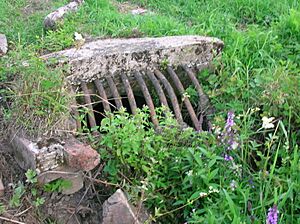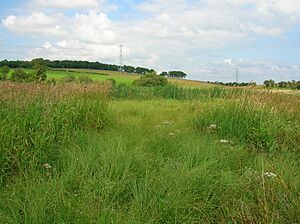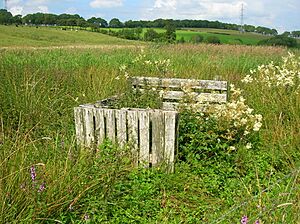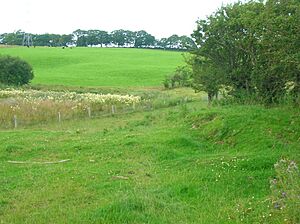Lochend Loch (Coylton) facts for kids
Quick facts for kids Lochend Loch |
|
|---|---|
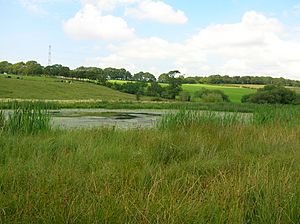
Lochend Loch
|
|
| Lua error in Module:Location_map at line 420: attempt to index field 'wikibase' (a nil value). | |
| Location | Coylton, South Ayrshire, Scotland |
| Type | Freshwater loch |
| Primary inflows | Joppa Burn, rainwater and field drainage |
| Primary outflows | Lochend Burn running to the Water of Coyle |
| Basin countries | Scotland |
| Surface area | Formerly 2–3 acres (0.81–1.21 ha) |
| Max. depth | Formerly 14 ft (4.3 m) |
| Surface elevation | 192 ft (59 m) |
| Islands | One |
| Settlements | Ayr |
Lochend Loch, which was once almost three acres big, is now a much smaller freshwater loch. It's located in South Ayrshire, Scotland, on a hill above a place called Joppa, between Gallowhill and Lochend Farm.
Contents
History of Lochend Loch
How the Loch Formed
Lochend Loch formed in a natural dip in the land after the last Ice Age. These dips are sometimes called 'kettle holes'. The loch gets its water from the small Joppa Burn, plus rain and water running off nearby fields. Its water then flows into the Water of Coyle river through a stream called the Barwhey Burn.
Old maps from the 1700s show that Lochend Loch used to be much larger. It even had a small, round island in the middle. However, around the late 1800s or early 1900s, the water level of the loch was lowered. This made the loch much smaller, and the island disappeared.
Changing Water Levels
Maps suggest that people could control the water level of the loch. This might have been done using a special drain. Today, in 2011, only a small part of the loch remains as open water. The rest has become a wetland area. The main drain now sets the water level, and the old ditch that carried water away is mostly filled in with a pipe inside it.
In the early 1800s, the loch was said to be about 4.3 meters (14 feet) deep. This depth is supported by signs of the old shoreline that can still be seen today.
Plants and Animals of Lochend Loch
The loch is a eutrophic place, which means it's very rich in nutrients. This helps many plants and animals to grow. Around the loch, there's a wide wetland area that gets drier as you move towards the surrounding fields.
You can find different animals here, like the willow warbler (a small bird), the European hare (a type of rabbit), and butterflies such as the meadow brown and small tortoiseshell.
Many types of wetland plants grow around the loch. These include different kinds of sedges, willows, and rushes. You might also spot wild angelica, hedge woundwort, yellow flag iris, and reed canary grass. In the open water, you can see yellow pond-lily floating. Other plants like reedmace (also known as bullrush), yellow meadow vetchling, and meadowsweet also grow here.
Sundrum Castle and the Loch
Lochend Loch is quite close to Sundrum Castle, though it wasn't part of the castle's fancy gardens. The current castle was built in the 1360s by Duncan Wallace, who was related to the famous Scottish hero, Sir William Wallace.
After Duncan Wallace died without children, the castle passed to the Cathcart family. They owned it for a very long time, until 1753. Then, it was sold to John Murray of Broughton. Within a year, the Hamilton family bought it, and they kept it until 1917.
Later, Sundrum Castle was sold to a hotel group. For a while, the castle fell into disrepair, meaning it became run down. But in recent times, it has been fixed up and restored.
Uses of the Loch
In the 1800s, Lochend Loch was a popular spot for winter activities. People used it for curling, a sport played on ice, and probably for ice skating too. Records show curling matches taking place here in 1820 and 1862.
The small island that used to be in the loch suggests it was a good place for wild birds to nest. People likely hunted wildfowl (like ducks and geese) and fished in the loch, as fish were present.
Today, in 2011, you can still see signs that the loch is used for wildfowl shooting, with special hides (places to hide) and feeding areas for pheasants.
A Bit of Local History
The loch was located on the land of Gallowhill Farm, which was part of the Sundrum Castle estate. The name 'Gallowhill' might mean that this was once the place where a gallows stood. In old times, a gallows was used for carrying out justice, often for serious crimes.


